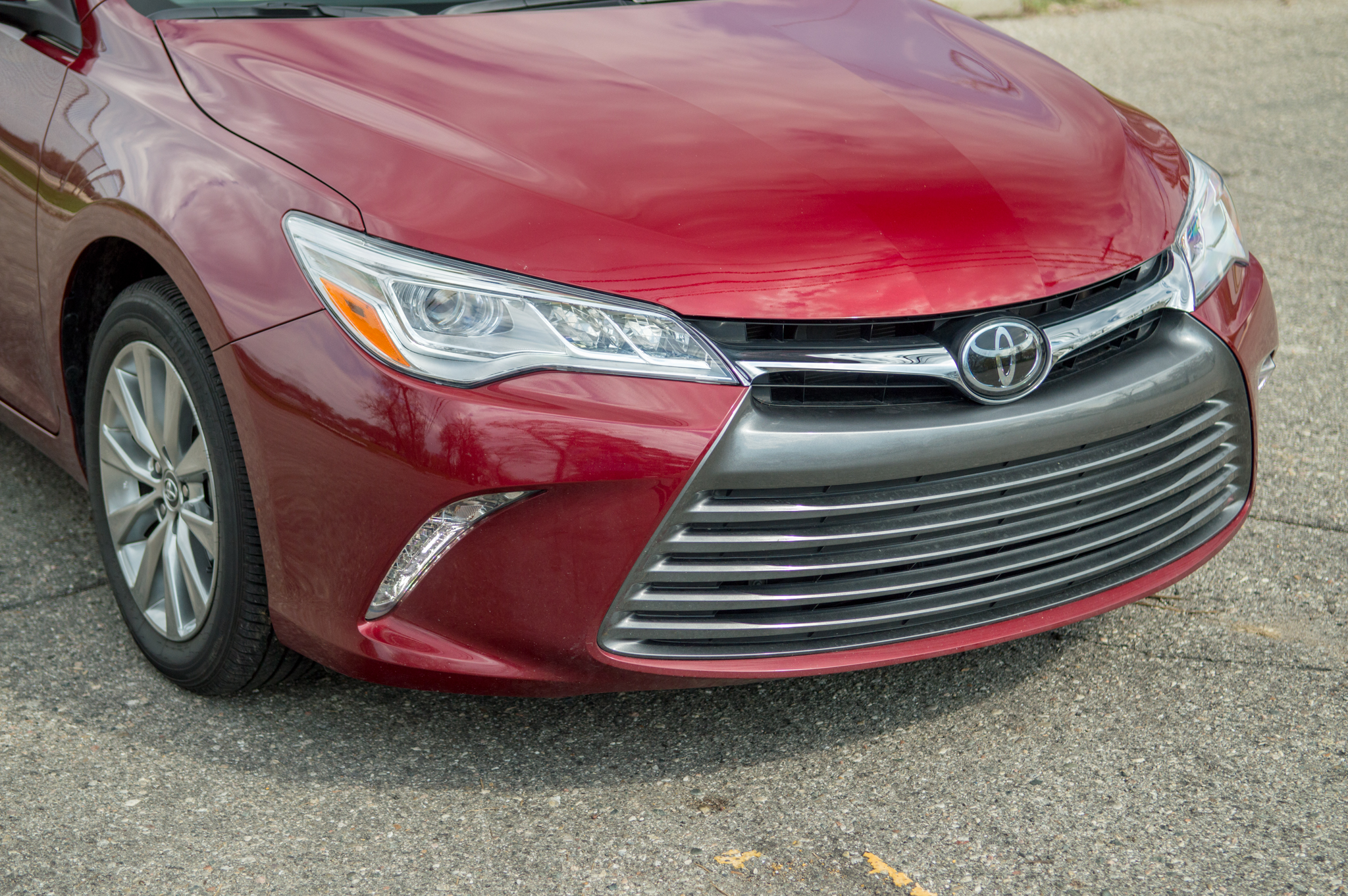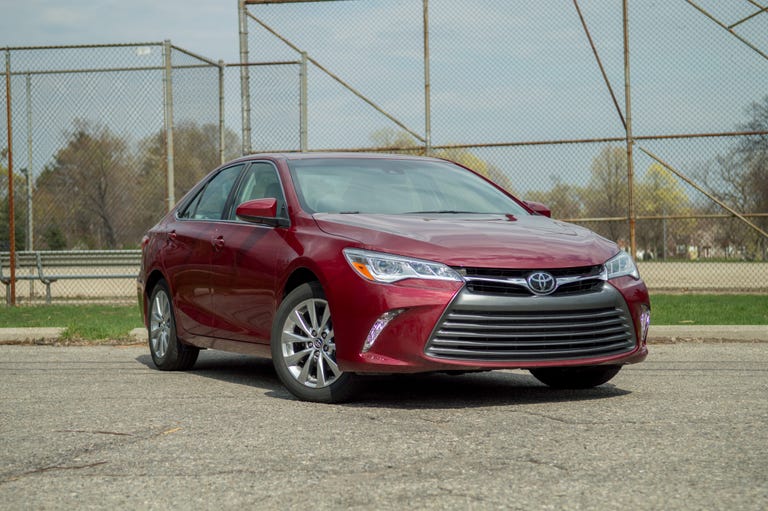 Why You Can Trust CNET
Why You Can Trust CNET 2016 Toyota Camry review: The 2016 Toyota Camry and the myth of the common man
The ubiquitous midsize family sedan is an exercise in utilitarianism, built to provide the greatest benefit to the most people possible.
If you tell a car enthusiast that you bought a Toyota Camry, you will hear something like "Oh, but it's so boring. There are so many more engaging cars on the market, like the Honda Accord or the Mazda6." This might come as a shock to enthusiasts, but not every buyer wants a lively sprite of a car.
The Good
The Bad
The Bottom Line
Some -- or, dare I say, most -- buyers want a car that's practical, reliable and safe. It should get decent-to-good fuel economy, have enough space for the whole family and contain enough creature comforts to not leave owners wanting. And guess what? The Toyota Camry fits that bill wholesale. It will do everything the average buyer wants without breaking the bank (or the owner's back on a bumpy road).
Is it perfect? Oh, hell no. No car is. Does it jibe with my personal tastes? Not exactly. But, unlike some enthusiasts out there, I know it's a damn fine car for most buyers on the market. And they seem to agree with me, as the Camry held its place as the best-selling car in the US for March 2016.
Sharp looks, without edge
Toyota refreshed the Camry's face for 2015, giving it a slightly more aggressive countenance without making the whole thing some exercise in boy-racer aesthetics. The larger grille up front and more pronounced character lines at the rear keep the Camry looking fresh in the face of newer competitors, such as the Nissan Altima and Honda Accord. It's not as inoffensively uninteresting as it used to be, but it's still plenty anonymous on the road.

Toyota's gaping maw of a grille is inescapable. Best to embrace it before it consumes you, too.
Inside the Camry, the anonymity makes way for a bit of life. The nicely designed interior features multiple materials layered atop the dashboard, providing a flow to the door panels and off to the back seat. Our Camry is the XLE model, the luxury trim, and it has a look that's distinctly different from the sportier XSE variant or the more basic trim levels. The leather seat and steering wheel are both suitably soft, and the seats mitigate muscle fatigue on longer jaunts.
Of course, it's still an affordable midsize sedan, so there are some cut corners. The plastic atop the dashboard vents, on the center console and the window switch panel is very hard and is likely prone to scratching in very little time. The headliner is made from the same material that holds multiple McDonald's cups. And Toyota hasn't yet equipped the Camry with an electronic parking brake, so you'll still be ratcheting down a foot pedal.
But, on the whole, the interior is just about perfect for your average buyer. It's immensely capacious, with above-average rear legroom and a roof that's high enough for taller drivers. Between the center console, complete with Qi-style wireless charging pad, and the purse-sized storage cubby nestled betwixt the seats, storage space is ample. The cupholder fits an iPhone 6S Plus or a large fast-food cup. There are two 12-volt plugs up front, along with one USB 2.0 port, but there are no plugs whatsoever for the back seat.
Straightforward, accessible tech
Speaking of in-car tech, the 2016 Camry features more than enough newfangled tricks to appeal to general audiences. We'll start with most obvious way to access these systems -- the optional 7-inch screen smack dab in the center of the dashboard (the standard one's a bit smaller).
You'll undoubtedly be pleased to learn that Kelis' "Milkshake" sounds great on the Camry's optional JBL speakers.
Toyota's Entune touchscreen infotainment system has been decried as too simple for some, but given the wide breadth of Americans who buy these cars, I think it's laudable in its simplicity. Positively ginormous buttons and dials for various infotainment functions flank large tiles on the screen, which might be a bit too large-print-magazine for some, but I see them as easy to read and access while in a moving vehicle.
Entune is loaded and ready to go between five and 10 seconds after starting the car, which is on the quick side. I managed the Bluetooth phone pairing process, using screen and phone, in 30-45 seconds.
Navigation is part of an $805 package that includes upgraded JBL audio components, the aforementioned larger touchscreen, Siri Eyes Free and Entune Apps, the latter of which includes connected services like up-to-date weather maps, real-time traffic information and third party apps such as Yelp and Slacker Radio. The speakers sound off with solid range and ample fidelity until you really crank it, which most buyers won't.
A second display nestled between the gauges shows pertinent information including navigation directions, audio information, fuel economy readouts and vehicle settings. Once you figure out which side of the steering wheel controls the screen (it's the right), navigating its menus is easy peasy, even at speed.
Driving impressions: 75% of the Lexus experience
When you set foot in one of Toyota's Lexus luxury vehicles, you're met with vaultlike silence and a driving experience that's largely disconnected from the rest of the world (in a good way). The Camry XLE is nearly Lexus-good, but with a price more suited for the hoi polloi.
Our tester came with the 268-horsepower, 3.5-liter, naturally aspirated V-6, which is more of a niche engine. By and large, buyers will favor the less powerful four-cylinder, which saves both fuel and money. But if you do have a lust for a bit of power, the V-6 supplies it in spades.
One issue I have with the Camry's interior is that the front seat doesn't get low enough. You feel like you ride atop the seat, rather than in it.
Save for a bit of a herky-jerky gas pedal that could be attributed to previous lead-footed testers (cars occasionally program pedal response and the like to match the driver's preferred driving style), the V-6 hustles you away with ease. The engine and its six-speed automatic are largely in the background until you step on the pedal, when you're met with ample forward thrust and a pleasing little grunt from the exhaust.
In every other condition, the powertrain is almost entirely invisible. Shifts, rises and falls in engine speed and quick downshifts are all smooth, bordering on barely noticeable. Noise, vibration and harshness are all Lexus-caliber, except for emergency stops, when the transmission shudders a bit. When you do need to stop, the pedal provides good, consistent feeling from highway speeds to no speed.
Despite the V-6's thirst trumping that of the four-banger, the six regularly returned 30 mpg on Michigan highways, where the average traffic speed runs 80 to 85 mph. In the city, the fuel economy dropped to sub-20, and it all averaged out to about 24 mpg, which is not too shabby for a V-6.
Enthusiasts will bemoan the steering, which is numb on center (and throughout, for that matter), but it turns the car without requiring giant forearms, which is all most people care about.
The suspension rests on the softer side of Sears, absorbing both small and large pavement inconsistencies with minimal noise and shudder. It's not the full-on luxury experience, which largely feels like a boat adrift in the ocean, but its suspension is more absorbent than its colleagues from Honda or Mazda.
And therein lies the crux of the Camry's appeal. The "engaging" ride of the Honda Accord and Mazda6 might be construed as jumpy and too harsh for buyers not used to that sort of thing. The Camry's ride suits drivers interested in getting from Point A to Point B with minimal muss and fuss.
Cruise control that really cruises
Being a slightly older model (the 2015 refresh was a mid-lifecycle upgrade), the 2016 Camry does contain some advanced driver assistance systems. As part of a $750 Advanced Tech package, our tester came equipped with forward collision warning, autonomous emergency braking, lane-departure warning, adaptive cruise control and automatic high beams.
ADAS-related warnings will appear in the center-mounted information display nestled between the gauges.
With the exception of the stalk-controlled adaptive cruise control, all driver aids are turned on by default. Adaptive cruise starts at about 25 mph and goes up to 108, but it won't bring you to a full stop if traffic does, so you'll need to be paying attention. On your average highway, though, the cruise control accelerates and brakes smoothly to match the pace of traffic.
Lane-departure warning is far too finicky, going off at times when it appears the vehicle is nowhere near the side of the lane. It also displays a message when you deviate from your lane on a side street, so if you navigate around parked cars, expect a bunch of "LDW not active at speeds below..." warnings, which gets annoying quickly. There is no auto-steer capability to prevent lane drift.
Down to brass tacks
The XLE is Camry's highest trim, and this car is more or less fully loaded. Base price on a XLE V-6 is $31,370, and our tester came in at $35,170, including $835 for destination. Blind-spot monitoring continues to be a $500 standalone option here, and this specific paint job (ruby flare pearl) added another $395 to the mix. Also included in the price is a $515 Safety Connect system, which includes roadside assistance, a stolen-vehicle locator and automatic crash notification.
Compared to some of the other vehicles in its segment, like the new Hyundai Sonata or the venerable Honda Accord, the Camry does a good job of playing C Student. Its performance sits in the middle of the pack, as does its features list, which must now play second fiddle to the "throw every possible option we have at it" mentality of Hyundai.
But being average is what the Camry does best. It provides a solid value, solid driving dynamics and a solid equipment loadout for buyers who don't write think-pieces on the brilliance of a well-tuned chassis. It's not "too much" in any one direction, nor has it ever been, which is why buyers are willing to flock to it like seagulls to a Meijer parking lot.


